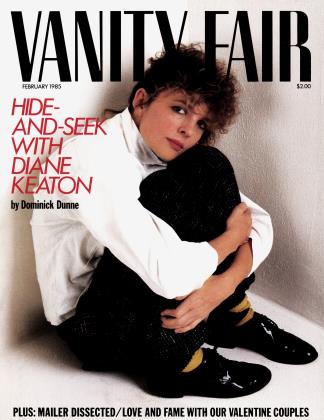Sign In to Your Account
Subscribers have complete access to the archive.
Sign In Not a Subscriber?Join NowOut to Lunch
Or, My Meal with Millau. PHILIP NORMAN rates a repast with restaurant critic Christian Millau
Christian Millau's choice of a New York rendezvous for lunch was not Elaine's or Tavern on the Green, where they probably have mantraps set for him, but Petrossian, the caviar specialists on West Fifty-eighth Street. I arrived first and strolled around the rose-lit interior, looking at the piledup caviar tins, the Erte mirrors, the fierce, black smoked eels, and listening to the subdued excitement that heralded the advent of "a famous French food critic."
Millau resembles nothing so portly or portentous. At fifty-four, though white-haired, he is trim and wiry, like one of those madcap French Rugby players. The simile is apt for one whose method of bringing down culinary pretension is by flying tackle, face forward into the mud.
Meeting Millau without Gault felt somewhat like meeting Gilbert without Sullivan. To those who keep Gault-Millau's The Best of New York for bedside reading, their two names constitute a single fine palate, sturdy stomach, all-seeing eye, and wicked wit.
One pictures them always together at a comer table, symbiotically rhapsodizing about Le Cirque or Lutece, chuckling with scarcely less relish as they agree that a noted Upper East Side restaurateur smiles "with the charm of a slammed door" or that the banana cheesecake at another self-satisfied establishment "would have smothered Desdemona more quickly than her pillow."
In fact, Henri Gault and Christian Millau have not worked as a team since the sixties and seventies, when they produced their classic handbooks on European cuisine. Although The Best of New York bears their famous joint byline, the writing is almost entirely by Millau. "Henri and I are still ve' good friends," Millau says, sounding oddly British. "He now has his own business in Paris as a marketing consultant. I gave him my name for his company, although it has nothing to do with the guides. He is also Gault-Millau. We have divided ourselves equally."
My attention was distracted by the arrival before me of Petrossian's Royal Gourmet Presentation, which features three caviars—beluga, sevruga, and osetra—beaded gray-gold in twined silver chalices. Millau had opted for Scottish smoked salmon. Tearing a roll apart as only a Frenchman can, he began to peel the delicate veined flesh from his plate and tell me how he became the funniest writer on gastronomy since Brillat-Savarin.
He was bom in Paris of mixed French and Russian parentage. His father was a banker; his mother, a pianist. His mother could not cook in the technical sense but could make anything taste wonderful. It was a talent put to good use during the Nazi occupation, when the Millau family had to survive on two hundred grams of meat each per week, eked out with potatoes and frosty turnips. To this day, the meal Millau remembers best is one he ate on the avenue Foch the day after Paris was liberated, when an American soldier gave him some K-ration ham and cookies.
He took a master's degree in law, became the youngest journalist on Le Monde ("That was ve' boring"), then worked for the daily Paris-Presse as features editor and reporter. Gault was also with Paris-Presse; their collaboration began in 1960 with a column listing the city's best restaurants and shops, in spite of objections from colleagues that such subjects were unworthy of serious attention. "In those days restaurateurs, bakers, charcutiers, were regarded only as artisans. We made them into stars."
As red snapper in mustard sauce was set before Millau, I asked if there was anything in the world he couldn't eat.
"No. I like everything. As long as it isn't bland."
In Gault-Millau guides, hilarity always yields to scrupulous judgment when it comes to awarding "toques," ⅛ the chef's-hat symbols of excel| lence. A restaurant serving dismal § food can redeem itself with an in| teresting wine list. Good intenS tions are detected as keenly as complacency is scorned. A firstclass restaurant whose chef is off form—like Le Gavroche in London—will receive detailed, downto-earth advice on how to stop the rot.
Millau understands the problems. He has himself worked in a restaurant kitchen—an education he recommends to all food writers. He also once cooked macaroni and sweetbreads for a bevy of great French chefs, including Paul Bocuse and Michel Guerard. "It took me ten hours, and I was exhausted for days afterwards. Think of doing that twice a day, 365 days a year, and always being inspired. It's phenomenal! I admire these people."
With other menus to tackle before his return to Paris, he thought he had better refuse dessert. Bustling into his coat, he confessed that, despite the risk of adding to the more than thirty lawsuits his reviews have attracted, there is nothing he enjoys quite so much as a totally dreadful restaurant.
"France is no fun for me anymore. If food is too perfect, it can become ve' boring. I love to be in England or Ireland or New York, because then anything can 'appen..There is an element of madness. Truly awful food, you know, is fascinating. To be really good is an art, but to be really, really bad—that is an art also."
 View Full Issue
View Full Issue












Subscribers have complete access to the archive.
Sign In Not a Subscriber?Join Now